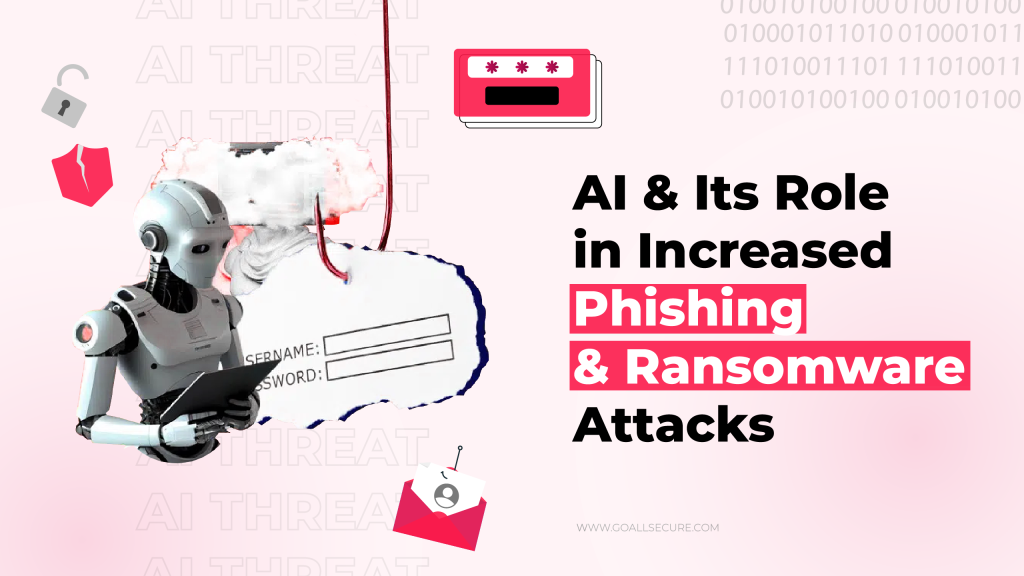Over the next two years, AI will increase the volume and intensify the impact of cyber attacks. The quick development of AI tools will surely raise the number of ransomware and phishing cyber attacks. Less experienced hackers will now be able to inflict more damage online due to the decreased entry barrier. Chatbots and other generative AI tools can produce more realistic phishing campaigns. Then there is the case of hackers with state support and their freedom to use AI in sophisticated cyber operations. In totality, AI is sure to send shock waves down the cyber security sector. This blog discusses at length the current AI role in phishing, ransomware and other cybercrime, the future of AI-based phishing and ransomware attacks and methods to defend against such attacks.
What Are Phishing and Ransomware Attacks?
Phishing and ransomware have emerged as the most prevalent types of cybercrime in recent years, posing an ever-growing threat to businesses. These attacks have affected almost all organisations, regardless of size or industry. If you’re unfamiliar with these two, let’s start by explaining a cyber attack before discussing its many forms and associated risks. In simple terms, the exploitation of computer systems and networks with malicious intent is known as a cyber attack. Threat actors employ malicious software to alter computer code, logic, or data, frequently leading to identity and data theft.
Now, ransomware is a type of malicious software created exclusively to extract money from its targets. These are malware to prevent an individual or group from accessing their computer’s files. This cyber attack puts companies in a situation where paying the ransom is the simplest and least expensive option to get access to their files again by encrypting these files and requesting payment in exchange for the decryption key. Some versions of the virus have included other features, like data theft, to entice ransomware victims to pay the ransom. Until a ransom is paid, victims are prevented from accessing their data. If businesses aren’t already worried, they should be since ransomware is a rapidly expanding threat.
And phishing is the preferred method of spreading ransomware and other malicious software. Phishing schemes remain one of the most prevalent forms of cyber attacks. Attackers pose as respectable companies like banks or well-known websites to trick victims into divulging sensitive information like passwords, credit card numbers, or personal data. Phishing attacks usually occur through email, instant messaging, or phoney websites. Cyber awareness and education are essential to avoid these trickery methods.
The Role of AI In Cyber Crime: How Is It Making Things Worse?
The amount of physical labour needed for ransomware attackers to plan, execute and be successful in a cyber attack is a lot. Their work is cut out for them and is riddled with weighty complications. Many of these restrictions are removed when AI enters the picture. Security professionals have seen that hackers are utilising AI at a rate that is comparable to, if not faster than, that of enterprise technology teams. Attackers of all skill levels can employ AI to expand the number of attacks their group can launch. They can even enhance the attacks’ potency and help their criminal organisation overcome its shortcomings. AI is being used by criminals to streamline current processes and automate laborious tasks. How does that affect us? Very badly, we would say. Have a look at some ways AI is making things worse:
Hiding in Plain Sight
Cybercriminals are using AI to blend data exfiltration into regular traffic to blend in and conceal it. As a result, organisations will find it more challenging to identify and thwart these attacks.
Automating Research
Artificial intelligence (AI) can combine information from several websites to create a more potent, quicker phishing attack that targets a more significant number of possible targets than human researchers would be able to do on a single site. Threat actors are using AI to automate target studies.
Enhanced Phishing Attacks
Already, AI is swift and proficient at creating precise and convincing phishing messages. The prevalence of grammatical and spelling problems in phishing emails used to make them easy to identify, but artificial intelligence (AI) is now making it simple for hackers to create well-written, convincing content for phishing scams.
AI Impersonation
It is growing in frequency and enabling criminals to conduct vishing scams. To conduct a vishing or any other type of phishing attack, a cybercriminal assumes the identity of a friend, family member, or coworker of the target. AI impersonation is making it so easy for them to be convincing.
Prevalence of Deepfakes
Deepfakes are artificial intelligence-generated fake media in which a person’s face or body has been manipulated to make them appear unreal. Malicious users frequently employ deepfakes to disseminate misleading information.
According to experts, some of the most significant new risks are caused by the quick development and spread of artificial intelligence. Organisations are already facing a danger from cyber attacks facilitated by artificial intelligence. The increasing advancements in AI methodology and the increased availability of AI expertise will only serve to heighten the security danger.
How to Defend Yourself with AI-driven Defense Strategies
As the digital landscape evolves, ransomware and phishing attacks, in particular, remain a significant threat. The good news is that organisations have a range of options for strengthening their defences against these kinds of attacks. If AI is being used for bad things, there is also a way to use it for the good. AI-powered security solutions can boost an organisation’s cyber defences, especially when combined with traditional security protocols.
- Cyber security products and services like managed detection and response (MDR) can more effectively identify threats and notify security personnel about them by incorporating AI algorithms. AI will provide security teams with information that is pertinent and concise, enabling them to identify and mitigate legitimate threats more quickly.
- Machine learning methods, when used in AI-based security log analysis, allow for real-time examination of massive amounts of security log data. This enables the teams to respond to threats more quickly when they spend less time hunting down false positives and trying to interpret security logs.
- Even in the lack of a known threat profile, AI algorithms are capable of identifying trends and anomalies that could point to a security breach. Data breaches and other security events can be prevented as a result of organisations’ ability to detect and address possible security incidents promptly.
- Organisations should not forget that completely relying on AI for security will be a mistake at this point of time. Therefore, they should pair AI-driven solutions with traditional security measures. This will include regularly updating security apps and software and applying patches for known vulnerabilities, guaranteeing that your systems have the newest security features.
- Backup copies of all the data on your devices should be kept at all times. This is not just a cyber security recommended practice; it also safeguards your data in the event that your gadget becomes lost, stolen, or breaks.
- Using multi-factor authentication i.e. having various forms of verification, adds an additional degree of protection. Organisations may drastically lower the likelihood of unauthorised access by putting MFA into place.
- Phishing scams aim to trick users into disclosing personal information that hackers can exploit to get access to their accounts or steal their money. One should always be cautious about sharing personal information because phishing scams can happen through text messages, phone calls, or emails.
- Companies that regularly undertake security assessments, train staff on best practices, create incident response plans, and work with cyber security specialists can reduce risks and stay one step ahead of cybercriminals.
Acknowledging the Dual Nature of AI in Cyber Security
Attackers can use AI technology to increase the complexity and potency of their cyber attacks, which presents serious difficulties. We have learned so far that the prevalence of AI tools that can produce code has given threat actors more ability to craft a broader range of attacks. Cyber attacks using AI present a severe risk to businesses of all sizes. These attacks can cause extensive harm, are highly targeted, and go past conventional cyber security defences. Traditional cyber security solutions feel insufficient as AI-powered cyber attacks get increasingly complex. But in this dark age, there is a silver lining: AI-powered solutions. These solutions can recognise and react to the changing danger, and they must be implemented by organisations. It may sound like science fiction, but with the correct technology and tweaking your defences can assist in thwarting malicious actors.
As data breaches are constantly changing, organisations need to realise that more than using a single strategy is required. To be safe and compliant in a digital age, artificial intelligence and human factors must be combined. AI enables cyber security teams to create strong human-machine alliances that advance one’s understanding and advance cyber security in a way that is more potent than the sum of its parts. GoAllSecure can help you navigate all the details and protect you and your organisation from cyber-attacks. We can support you in implementing the best practices and shield you from the most invasive attacks. If you want to defend your networks from hackers, kindly contact us at +91 85 2723 7851 or +44 20 3287 4253.

















 TRAVEL & HOSPITALITY
TRAVEL & HOSPITALITY HEALTHCARE
HEALTHCARE RETAILS & ECOMMERCE
RETAILS & ECOMMERCE BANKING & FINANCIAL
BANKING & FINANCIAL AutoMobile
AutoMobile MANUFACTURING
MANUFACTURING FOOD
FOOD EDUCATION
EDUCATION



